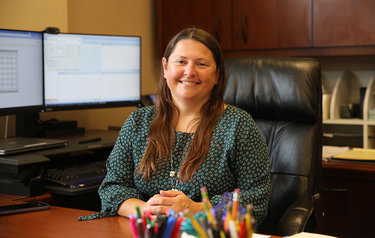Anderson, who values relationships, is prepared for the unexpected
GUILDERLAND — Rachel Anderson, the newest addition to the school district’s leadership team, says, “When we, not I, are looking at issues and what is best to do, we always keep students in mind. That drives our decisions.”
Anderson, who had worked as the high school’s director of math, science, and technology, was appointed in June to the $125,000-a-year post of assistant superintendent for curriculum and instruction.
Superintendent Marie Wiles said the job was posted widely and 35 people applied. “Rachel rose to the top …,” she said. “She’s a collaborative problem-solver. She’s bright. She’s hard working. She’s going to be terrific in that role.”
Demian Singleton had held the post since 2008. He died last October of pancreatic cancer. The work Singleton had done was then parceled into two separate jobs.
In March, the district hired David Howell to be its chief information officer and director of technology.
Wiles finds a “lovely symmetry” in Anderson’s appointment because Singleton, too, had moved to the post from being the director of math, science and technology — at the middle school rather than the high school.
She concluded of Anderson, “Rachel is thoughtful. She is good at bringing people together and bringing them along to think about curriculum or instructional practices.
Ag teacher
Anderson was born and raised in Greenville in a home where learning mattered. Her father worked as a physics professor and her mother worked as a librarian for the Albany Public Library, focusing on children.
Her family lived in a rural area and kept “a very big garden,” along with fruit trees and horses, said Anderson, stopping short of calling it a hobby farm.
Anderson left home for Cornell University. She went to Cornell’s College of Agriculture and Life Sciences with the dream of becoming a veterinarian. But, as she majored in biology, she became interested in teaching and stayed on to earn a master’s degree in science and agricultural education.
After teaching in Argyle for a year, Anderson returned to her alma mater and spent 16 years as an agriculture teacher at Greenville.
She was encouraged by “a great mentor,” her building principal, Michael Laster, to get administrative certification and did so at the University at Albany in 2007. Laster is now the principal of Guilderland’s Farnsworth Middle School.
Anderson said she turned down several job offers in administration because she “wasn’t ready to leave the classroom.” She taught career and technical education courses and applied science courses and advised student groups.
She served as department chair and she was busy starting a family with her “super supportive” husband, Steve Sarsfield, who works in the health field. They have a son, Declan, who will be a third-grader in Greenville in the fall and a daughter, Riley, who will be a second-grader there.
Ready for a new challenge
Finding her job in Guilderland was a “fluke,” Anderson said. She was helping a colleague relocate and, as they looked at various positions, she saw a posting for the job at Guilderland High School.
“They kept calling me back,” she said, and the more she learned about the district, the better she liked it.
“I needed a change,” said Anderson. “I was ready professionally for a new challenge.”
She talked it over with her family, accepted the job offer, and started work as the high school’s director of math, science, and technology in 2018.
Even though Guilderland is much larger than Greenville — Guilderland has seven schools with close to 5,000 students while Greenville has three schools with just over 1,000 students — Guilderland “still has that family feel,” said Anderson.
“Everyone really wants everyone else to succeed and everyone really is trying to do what’s best for students, which are values I share,” she said.
Anderson had been at her new job for just a year and a half when COVID hit. The pandemic, Anderson said, “changed the way we do business in education.”
Guilderland, as required by the state, first went to all-remote learning, and then the high school used a hybrid schedule with in-person and virtual classes alternating.
Anderson’s central focus, she said, was to get teachers the resources they needed and to help with all the logistics and coordination.
“We need to listen to teachers to guide us in what we do,” she said.
There were no perfect solutions and there were some rough patches along the road, she said, but students were able to learn despite the hurdles.
“I’m proud of how we came through that as a school district and how we’re still dealing with the after effects, which I think we’ll be dealing with for quite a long time,” Anderson said.
“Providing consistency”
In her new job, Anderson said, her immediate goal is to learn about the parts of the district she is unfamiliar with. Guilderland, in addition to a middle school and high school, has five elementary schools.
This summer, Anderson is meeting with each principal to learn the cultural nuances of every building as she tours each one. She looks forward to getting to know or strengthening relationships with teachers on each building cabinet.
Going forward, one of the things she wants to focus on is “providing consistency between school and coherence across grade levels,”Anderson said. She plans to pay special attention to the transition students make going from elementary school to middle school and then from middle school to high school.
Guilderland, like the rest of the world, is dealing with repercussions from the pandemic. Anderson believes it has always been important to support classroom teachers and, in her new role, she plans to listen to teachers and shift resources to fill needs, she said.
An emphasis on social-emotional learning resources is important, Anderson said. “We need to build relationships, not just academics.”
Those relationships, she said, include not just with students and faculty but other district employees as well.
The Positivity Project, introduced last year, will continue in the younger grades as will the Sources of Strength program in the high school. Such programs take a while to fully implement, Anderson said, describing Guilderland as currently being in the pilot stage.
Anderson also sees technology as important. Promethean boards were introduced several years ago, she said, referencing an interactive whiteboard that allows projections from a computer. More teachers are getting comfortable with using the Promethean boards, she said.
At the same time, every Guilderland student at the secondary level was given a device like a Chromebook.
“So absolutely, technology is still a centerpiece,” said Anderson. But, she went on, “There’s definitely a balance; technology is not a cure-all. You don’t want to use it for everything but, when used well, it can complement and enhance instruction.”
She also said, “Technology is everywhere in our lives,” so students need to know how to use it.
In addition to a focus on social-emotional learning, the other important district initiative that Anderson wants “to infuse” throughout is diversity, equity, and inclusion.
Anderson is enthused to work with Matthew Pinchinat, who was appointed last year to the newly created post of DEI director
“We’re keeping that lens in mind with everything we’re doing,” she said.
Reflecting on lessons learned through the pandemic, Anderson concluded, “We need to be prepared and we need to be thinking about how we can deal with the unexpected.”



